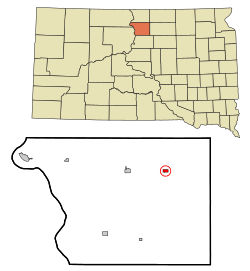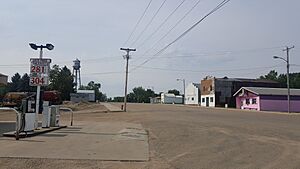Java, South Dakota facts for kids
Quick facts for kids
Java, South Dakota
|
|
|---|---|

Location in Walworth County and the state of South Dakota
|
|
| Country | United States |
| State | South Dakota |
| County | Walworth |
| Incorporated | 1903 |
| Area | |
| • Total | 0.49 sq mi (1.27 km2) |
| • Land | 0.49 sq mi (1.27 km2) |
| • Water | 0.00 sq mi (0.00 km2) |
| Elevation | 2,080 ft (630 m) |
| Population
(2020)
|
|
| • Total | 121 |
| • Density | 245.93/sq mi (95.02/km2) |
| Time zone | UTC-6 (Central (CST)) |
| • Summer (DST) | UTC-5 (CDT) |
| ZIP code |
57452
|
| Area code(s) | 605 |
| FIPS code | 46-32460 |
| GNIS feature ID | 1267440 |
Java is a small town in Walworth County, South Dakota, in the United States. In 2020, about 121 people lived there.
The town of Java got its name from Java coffee. People even called it "Coffee Town" for a while. This happened because railroad workers from the Chicago, Milwaukee & St. Paul Railway Line used to stop in the town for coffee. This was before the railroad tracks were moved in 1908.
Contents
History of Java
Java was started in 1900. This was soon after the Chicago, Milwaukee & St. Paul Railway Line built its tracks further west. The town officially became a town by election in 1903. A surveyor named George Merriman mapped out the town on September 5, 1903.
Many of the first settlers in Java came from different parts of Europe. They had German, Russian, Dutch, English, and Hungarian backgrounds. The first newspaper in Java was called The Java Herald. Carl F. Clement started it in 1903. It was printed in both English and German.
Early Town Improvements
In 1904, Java built its first public building, which was a jail. The town also added gravel streets and a fire station. This station had a fire engine, hoses, and other important fire fighting tools. The Dakota Central Telephone Company also set up a telephone booth and a switchboard. These were located at The Java House, which was Java's first hotel. H. A. Taylor started this hotel in 1900.
Later, the town added wooden sidewalks, a water storage tank, a town hall, and a town well. They also built a windmill to grind grain. The town paid for these additions using special financial papers called warrants. In 1906, the town approved a $2,000 bond. This money helped pay off the debt from these improvements.
In 1905, two brothers, J. C. and George Kupp, helped install a better telephone system. They worked for the Dakota Telephone Co. By 1907, Java had fire protection and a group to manage the cemetery. It also had a good water supply and improved telephone services. The Milwaukee Land Company also added more land to the town.
Railroad Changes and Growth
Between 1908 and 1909, the railroad company changed its tracks. The new tracks went about half a mile north of the town. Railroad officials suggested moving the entire town north. However, the people of Java said no. After that, the railroad built a short side track to serve the town.
By 1913, Java had several churches. These included a Catholic church, a Presbyterian church, a German Lutheran church, and a German Congregational church. In 1915, the wooden sidewalks on Main Street were replaced with stronger cement ones. Later that year, the town hall was updated. The jail was moved, and a bell tower was built. In 1916, the town built its own power plant for lights.
In 1921, a new schoolhouse was built. Around this time, Java changed from a town to a city. It started using a Mayor-Alderman form of government. Carl F. Clement became the first mayor under this new system. In 1939, a big project began to create a water system. This system provided water to both businesses and homes.
In 1947, a park board was created. This board set up a city park just west of the school house.
Java High School
In 1901, the first school classes were held in a building that had been moved into town. There were 23 students, from ages five to eighteen. In 1903, a wooden school building was built. It was located two blocks east of Main Street. This building was used until 1921. That's when the new, fireproof brick schoolhouse was built.
Geography
Java is located in South Dakota. According to the United States Census Bureau, the town covers an area of about 0.49 square miles (1.27 square kilometers). All of this area is land.
Population Information
| Historical population | |||
|---|---|---|---|
| Census | Pop. | %± | |
| 1910 | 473 | — | |
| 1920 | 527 | 11.4% | |
| 1930 | 529 | 0.4% | |
| 1940 | 493 | −6.8% | |
| 1950 | 433 | −12.2% | |
| 1960 | 406 | −6.2% | |
| 1970 | 305 | −24.9% | |
| 1980 | 261 | −14.4% | |
| 1990 | 161 | −38.3% | |
| 2000 | 197 | 22.4% | |
| 2010 | 129 | −34.5% | |
| 2020 | 121 | −6.2% | |
| U.S. Decennial Census | |||
2010 Census Details
In 2010, the town of Java had 129 people living there. These people lived in 69 households, and 38 of these were families. The town had about 263 people per square mile. Most of the people (93.0%) were White. About 3.1% were Native American, and 3.9% were from two or more races.
The average age of people in Java was 57.1 years old. About 14% of the residents were under 18 years old. About 37.2% were 65 years old or older. The town had slightly more females (55.0%) than males (45.0%).
See also
 In Spanish: Java (Dakota del Sur) para niños
In Spanish: Java (Dakota del Sur) para niños





